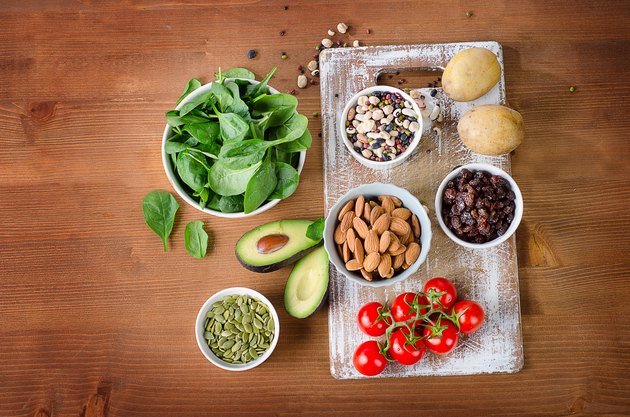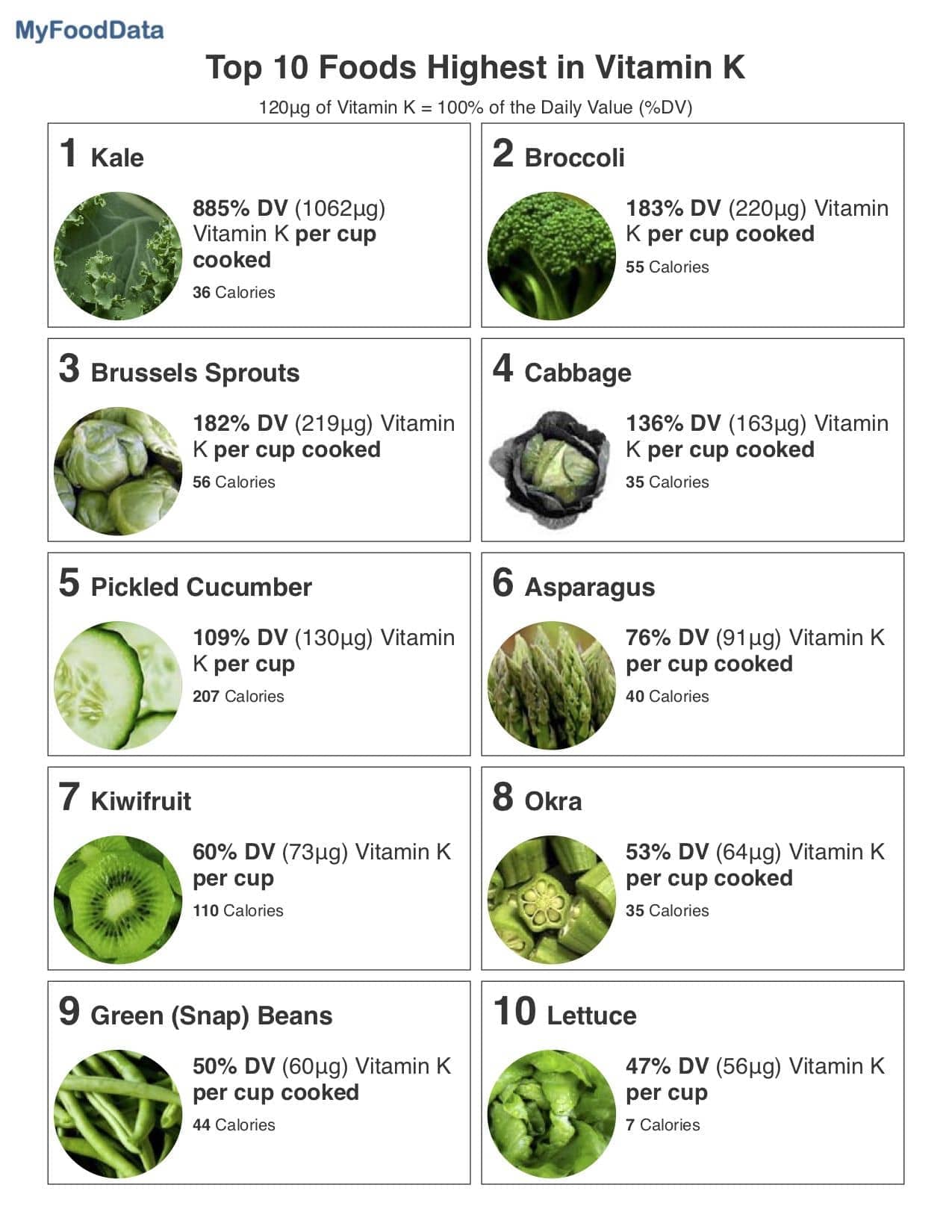
Hi, good morning, This article will explain about foods containing vitamin k Why Leafy Greens Are Even Healthier Than You Thought | Livestrong.com see in full
Vitamin K can be found in a wide variety of foods
Image Credit: bit245/iStock/GettyImages
Your body needs vitamin K for many important functions, including healing wounds, maintaining blood vessels, preventing excessive bleeding and keeping your bones strong to prevent fractures. As if that weren't reason enough to seek out the nutrient, a study published in May 2019 in found that it's also key to helping us maintain our mobility, especially as we age. In fact, researchers found that having low levels of vitamin K is linked to chronic diseases that lead to disability. While your body can make some of this nutrient, the best sources are in your diet. Learn how much you really need, and which food sources pack the biggest K-pow.

What Is Vitamin K, Anyway?
Vitamin K is a fat-soluble nutrient needed for the normal function of at least 15 proteins, which are required for such bodily processes as coagulation, mineralization of tissue and regeneration of the nervous system. These proteins are also essential when it comes to your cognitive health, according to a review article published May 2018 in . And, pro tip: Pairing your K1-rich food with a source of fat helps your body to better absorb it.
Vitamin K2 is produced by bacteria in your intestines, according to the NIH. It is also found in sources that involve microbial activity, including such animal-based foods as meat, dairy, eggs, yogurt and cheese.
Causes of Vitamin K Deficiency
If you are taking certain medications or have some types of medical conditions, you may not be able to absorb an adequate supply of vitamin K from the foods you eat. Some things that may increase your risk of deficiency include:
- Eating a diet lacking in vitamin K foods
- Restricting the fat in your diet
- Being pregnant
- Having a disease that inhibits fat absorption, such as cirrhosis and chronic cholestasis
- Taking barbiturates and salicylates
- Having a condition that causes malabsorption, such as Crohn's disease, cystic fibrosis, pancreatitis or colitis
- Prolonged use of some antibiotics, anticonvulsants or mineral oil
- Use of anticoagulant medications such as warfarin
Symptoms of Deficiency
Because some vitamin K is synthesized by bacteria in your intestines and stored in the liver, a deficiency is rare, according to the NIH. However, if any of the risk factors listed above apply to you, watch for signs or symptoms that include:
- Bruising easily
- Nosebleeds or bleeding gums
- Excessive bleeding from a wound
- Blood in the urine or stool
- Vomiting with blood
- Heavy, painful menstrual cycles
- Joint inflammation and pain
- Osteopenia, or loss of bone density
- Bones fracturing easily
So, How Much Do You Need?

By eating a balanced diet that offer recommended daily intakes of the vitamin, dependent on age and gender. These are:
- Ages 1 to 3: 30 micrograms
- Ages 4 to 8: 55 micrograms
- Ages 9 to 13: 60 micrograms
- Teens 14 to 18: 75 micrograms
- Women: 90 micrograms
- Men: 120 micrograms
Warning
If you take a blood thinner medication such as warfarin, your doctor may advise that you consume a consistent amount of vitamin K each day. According to the , warfarin helps keep your blood thin by decreasing vitamin K activity. Your warfarin dose is dependent on this activity and eating too much or too little vitamin K may affect how well your medication works.
Vitamin K Sources: Vegetables
Vegetables are the best source of vitamin K. Skip the iceberg lettuce in your salad and sandwiches and reach for romaine lettuce or other green leafy vegetables, which rank exceptionally high in the nutrient. You can easily fulfill much more than your daily value (DV) with just a 1-cup serving.
And don't worry about consuming too much vitamin K. It is not known to be toxic, according to , include:
- Kale: 885 percent DV
- Spinach: 740 percent DV
- Collards: 644 percent DV
- Beet greens: 581 percent DV
- Turnip greens: 441 percent DV
Other good vegetable sources of vitamin K (all per cup, cooked, except for the cucumber) are:
- Broccoli: 183 percent DV
- Brussels sprouts: 182 percent DV
- Cabbage: 136 percent DV
- Pickled cucumber: 109 percent DV
- Asparagus: 76 percent DV
Vitamin K Sources: Fruit
Many fruits are also good vitamin K sources, including dried fruits. , uncooked prunes contain the the most. Some fresh fruits that are good sources, per cup, are:
- Kiwifruit: 60 percent DV
- Yellow plantains (fried): 45 percent DV
- Avocado (California, pureed): 40 percent DV
- Rhubarb (diced): 30 percent DV
- Blueberries and blackberries: 24 percent DV
- Grapes: 11 percent DV
- Plums: 9 percent DV
- Raspberries: 8 percent DV
- Pears: 5 percent DV
Vitamin K Sources: Meat
Meat provides a moderate amount of vitamin K2. Some examples of meats that are rich in vitamin K, , include:
- Chicken leg (roasted): 8 percent DV
- Chicken breast (cooked): 6 percent DV per 6 ounces
- Chicken thigh (roasted): 4 percent DV
- Duck (roasted): 4 percent DV per cup, chopped
- Lamb (ground): 4 percent DV per 3 ounces
- Canned beef: 4 percent DV per serving
- Skirt steak: 2 percent DV per 6 ounces
- Beef hamburger: 2 percent DV per 3 ounces
- Beef steak: 1 percent DV per 3 ounces
Vitamin K in Nuts
Snacking on nuts and seeds is a healthy way to contribute to your vitamin K intake. Some good sources (per ounce), , are:
- Pine nuts (dried): 13 percent DV
- Cashews (dry-roasted, oil roasted or raw): 8 percent DV
- Chestnuts (roasted): 5 percent DV
- Hazelnuts: 3 percent DV
- Pistachio nuts: 3 percent DV
- Pumpkin and squash seeds (dried): 2 percent DV
Vitamin K Sources: Grains
Grains and pasta contain a minimal amount of vitamin K — not as much as vegetables and most fruits. If the pasta has vegetable ingredients added, such as in the case of spinach egg noodles, the vitamin content will be a lot higher — 135 percent DV per cup — compared to a typical whole-grain products. The DV for vitamin K in some grains (per cup), , is:
- Whole-grain sorghum flour: 6 percent DV
- Buckwheat groats (roasted): 3 percent DV
- Oat bran: 3 percent DV
- Pearl barley (cooked): 1 percent DV
- Wild rice (cooked): 1 percent DV
- Oatmeal (cooked): 1 percent DV
There is no vitamin K in brown rice, cornmeal, couscous or rice bran.
Vitamin K Sources: Dairy
Milk products, including eggs and cheese, are not a very good source of vitamin K. Some of the DVs per cup, , include:
- Whipping cream (light): 3 percent DV
- Fried or scrambled egg or omelet (1 egg): 2 percent DV
- Parmesan cheese (low sodium) or mozzarella cheese (fat-free): 2 percent DV
- Whole milk: 1 percent DV per 16 ounces
Vitamin K Sources: Fish
Overall, fish and seafood are not particularly good vitamin K sources. Canned fish offers the highest DV per serving, .
- Canned white tuna (oil packed): 5 percent DV per 3 ounces
- Atlantic mackerel (raw): 5 percent DV per fillet
- Canned sardines: 3 percent DV per cup
- Canned anchovies: 2 percent DV per 5 anchovies
Vitamin K Sources: Oils
Some oils contain vitamin K, with soybean oil containing the most. Per tablespoon, the DVs of some common oils are as follows, :
- Soybean oil: 21 percent DV
- Canola oil: 8 percent DV
- Olive oil: 7 percent DV
- Sesame oil: 2 percent DV
Peanut oil, avocado oil and coconut oil do not contain any vitamin K.
Sprinkle on Some Vitamin K
Increase your vitamin K intake by generously flavoring your foods with , are:
- Dried coriander: 20 percent DV per tablespoon
- Dried basil: 10 percent DV per teaspoon
- Fresh basil: 9 percent per 5 leaves
- Ground sage: 10 percent per teaspoon
That is it discussion the subject Why Leafy Greens Are Even Healthier Than You Thought | Livestrong.com hopefully writing this beneficial salam
Article this was posted on label foods containing vitamin k, foods containing vitamin k warfarin, foods with vitamin k 2,
Comments
Post a Comment